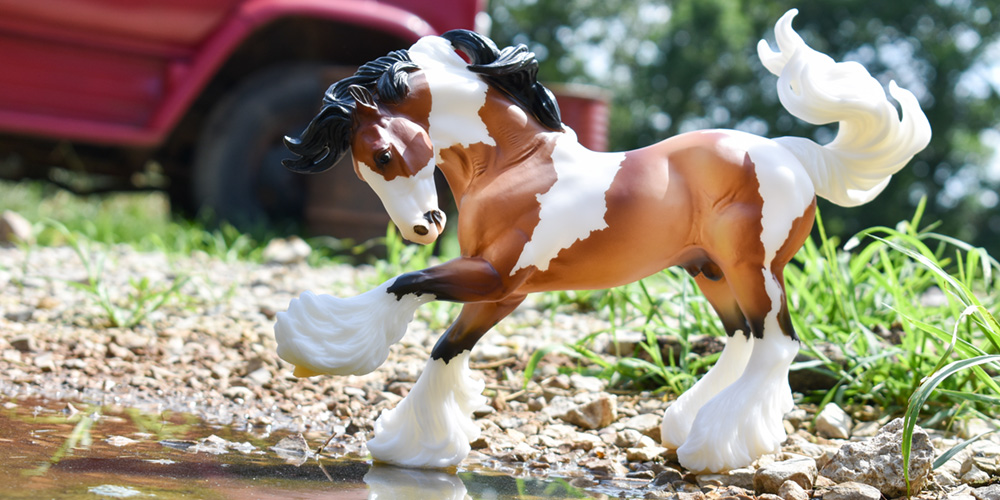
Forever in Our Hearts:
Breyer Model Horses with Ocala Connections (Part 1)
by
Cynthia McFarland
Proudly displayed on a shelf or carefully packed away in a box of sentimental childhood mementos, many horse lovers have at least one Breyer® model horse.
Collectors often spend many hours and hundreds of dollars to track down and purchase in-demand Breyer models. Model horse aficionados are found in all demographics and many countries.
The company whose creations have touched so many lives around the world began as the Breyer Molding Company. The Chicago-based company released its first model horse in 1950 as a special order for the F.W. Woolworth Company. Known as the #57 Western Horse, this model was created specifically to embellish a mantel clock. Consumers, however, wanted to purchase the horse on its own. As a result of this demand, the company completely changed direction and launched the Breyer Animal Creations® brand of model horses and accessories.
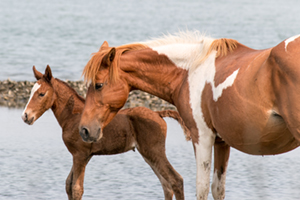
Reeves International continued to grow and expand the Breyer model line, and Breyer became known worldwide as the premier brand of model horses. Fleischmann’s son, Anthony, bought the business from his father in 1998. Breyer continues to be the company’s signature brand.
Decades ago, Breyer began immortalizing famous horses–both fictional and real. Decades ago, Breyer began immortalizing famous horses–both fictional and real. For example, in 1962, Breyer released a model of the fictional horse Fury, making him one of the company’s earliest portrait models. Another literary hero horse, Black Beauty, was made a Breyer model in 1979.
Chincoteague ponies Misty and her foal Stormy gained popularity thanks to Marguerite Henry’s book, Misty of Chincoteague. The earliest Breyer model of Misty was released in 1972, and Stormy followed in 1977. They are currently available as a set.
Choosing horses
So how do the folks at Breyer decide which horses to make into portrait models?
It’s a combination of the company keeping up with the industry and horse people reaching out with suggestions.
“We get tons of letters through email and ‘snail mail’ with proposals from owners, associations and fans,” says Stephanie Macejko, vice president of marketing and product development for Breyer.
“We also do a lot of research and keep an eye out for top horses and good stories,” she adds, noting that the company makes it a point to watch trends and keep up with journalists in the equine industry.“We also do a lot of research and keep an eye out for top horses and good stories,” she adds, noting that the company makes it a point to watch trends and keep up with journalists in the equine industry.
“Once we’ve determined which horse to do, the hard part is deciding which pose the horse will be in,” says Macejko. “We’ll look at poses we already have and if we’re working with a particular owner or trainer, we brainstorm to find something that showcases that particular horse’s personality and way of going.”
“We also do a lot of research and keep an eye out for top horses and good stories. Once we’ve determined which horse to do, the hard part is deciding which pose the horse will be in. We’ll look at poses we already have and if we’re working with a particular owner or trainer, we brainstorm to find something that showcases that particular horse’s personality and way of going.”
– Stephanie Macejko, vice president of marketing and product development for Breyer
Model creation
The talented Chris Hess sculpted many of the Breyer models through the 1980s. Since that artist’s death, Breyer has worked with 15 to 20 different sculptors all over the world.
These sculptors don’t all approach their art in the same way. Some travel to see the horse in person, while others work in their studios using images and videos of the horse.
Once a clay model is completed, an injection molding tool is made. Liquid plastic is poured into this to form the model horse.
Every Breyer model is hand painted by airbrush artists.
“There’s a lot of handcraftsmanship,” says Macejko. “A real person is applying the paint, which is why you’ll see subtle variations in shading and depth of color.”
When a horse is made into a Breyer portrait model, the total number of models produced by the company can vary. This number is determined by popularity and often, by whether or not the horse is still actively competing or is in the news.
“We like to represent all the different breeds and disciplines, so with some models we may make more because they’re a well-known champion or a very popular breed, and the demand is high. Some models will stay in the line for several years, some for a year, two or three,” says Macejko.
Held since 1990, BreyerFest® is an annual horse fair and model horse festival celebrating all things Breyer. Typically held in Lexington, Kentucky, at the Kentucky Horse Park, the three-day event draws thousands of enthusiastic fans from around the world.
The real horses who inspire the Breyer models regularly make live appearances. The next BreyerFest is scheduled for July 14-16, 2023.
Once a model is retired, no more are produced. This explains why in-demand models can sell for significant amounts after they’re out of production. Online auction sites like eBay sell all manner of Breyer models.
Collectors, buyers and sellers often use the website www.identifyyourbreyer.com to determine the scale, mold and model of Breyer horses.
“We like to represent all the different breeds and disciplines, so with some models we may make more because they’re a well-known champion or a very popular breed, and the demand is high. Some models will stay in the line for several years, some for a year, two or three.”
– Stephanie Macejko, vice president of marketing and product development for Breyer
Ocala connections
With the abundance of talented horses here in the Horse Capital of the World®, it’s not surprising that numerous horses with ties to Ocala have been made into Breyer models.
This story is the first in a three-part series that takes a closer look at many of the Ocala connection horses who have been immortalized by Breyer.We’ll cover five horses in this story, so be sure to catch Parts 2 and 3 coming soon to learn about the others!
The Gypsy King
(Breyer model #1148)
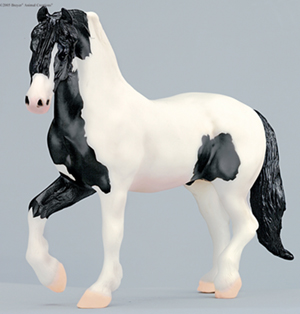
During a trip to England in 1994, they discovered the colorful, personable horses and learned their fascinating Gypsy heritage. The Thompsons were stunned to find that this intriguing horse was not officially named or recognized as a breed in the States. With the blessing of dedicated Gypsy Horse breeders in England, they chose the name Gypsy Vanner Horse and established the U.S. breed registry.
They imported the first stallions and Gypsy mares to the U.S. in November 1996. Among these was a stunning black and white tobiano stallion (barn name “Bill”) who became known as The Gypsy King.
The Gypsy King sired the first Gypsy Vanner Horse in North America and became a foundation sire. He was soon recognized as a “poster horse” for the breed.
Breyer was approached by the Thompsons about making The Gypsy King a Breyer horse model and he was presented in person at BreyerFest 2001. The Gypsy King became one of Breyer’s top 10 best-selling models for the year 2001.
It’s fair to say The Gypsy King became one of the most famous Gypsy Vanner Horses. Sadly, he was humanely euthanized in 2015 at age 24 after fracturing a foreleg in a breeding mishap.
Rugged Lark
(Breyer model #450)
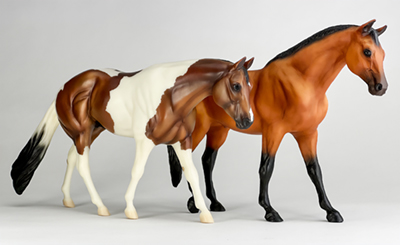
That fitting description is how owner Carol Harris of Bo-Bett Farm just north of Ocala, described her handsome Quarter Horse stallion. Rugged Lark became a breed legend, making his mark both in the show ring and as a sire.
Foaled in 1981, Rugged Lark amassed 326 performance points in both English and Western disciplines. He was the first American Quarter Horse to win the prestigious title of AQHA Superhorse twice—in 1985 and again in 1987. He then became the first Superhorse to sire a Superhorse, a feat he accomplished twice, first in 1991 with The Lark Ascending and in 1999 with Look Whos Larkin.
A charismatic ambassador for the American Quarter Horse Association, Rugged Lark brought crowds to their feet with his impressive bridle-less performances, including at the 1996 Olympic Games in Atlanta.
“He was a horse of a lifetime,” says trainer and long-time Ocala-based horsewoman Lynn Palm, who rode Rugged Lark during both his Superhorse winning efforts and for many bridle-less performances.
“He was the one that really promoted the versatility of the Quarter Horse. He entertained with his own personality; he really had a very special way about him,” says Palm, who rode the stallion in exhibitions for 10 years. Palm has shown more than 34 Quarter Horse world and reserve champions, competing in both English and Western disciplines.
With all of his accomplishments, it’s not surprising Rugged Lark was made a Breyer portrait model in 1989.
Rugged Lark was humanely euthanized on October 26, 2004, due to complications from colic. He was 23 years old.
Rugged Painted Lark
(Breyer model #711107)
Rugged Painted Lark (barn name “Bruce”) became a successful show horse and breeding stallion. For many years, he was the main horse Palm rode in all of her RFD-TV and HorseTV shows. He became the four-legged representative for Palm’s educational training programs.
His bridle-less performances, often performed to Mariah Carey’s hit song “Hero,” were crowd pleasers across the country.
“We competed in trail, Western riding and Western dressage, which was his forte,” says Palm. “He had a great fan base.”
He was even a Western dressage champion at age 22. He officially retired at age 24 following his final bridle-less performance at Equitana USA in 2021.
Rugged Painted Lark was a BreyerFest Celebration Horse in 2007. He and Palm appeared at the popular event the year his Breyer model was released.
The personable stallion lived in Ocala his entire life and passed in 2022 at age 25.
Zenyatta
(Breyer model #1478)
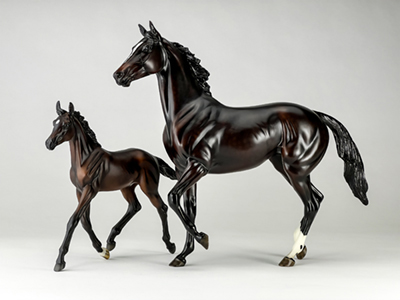
The farm is owned and operated by the mother-daughters team of Jeanne, April and Summer Mayberry, lifelong horsewomen who relish their job of breaking and training young equine athletes.
“We try to follow the racing careers of all our training graduates,” says Jeanne. “Zenyatta was impressive winning her first couple races. We thought she was the real deal, which she certainly proved to be.”
Indeed, Zenyatta proved herself to be the “real deal.” The big mare went on to win 19 of her 20 races for career earnings of $7,304,580. She broke the record for consecutive grade one victories, winning 13. In 2009, she became the first female to win the Breeders’ Cup Classic-G1 in a thrilling come-from-behind performance. The only race she ever lost was her final start in the 2010 Breeders’ Cup Classic-G1, which she lost by a nose.
A multiple Eclipse Award winner, Zenyatta was three-time Champion Older Female in 2008, 2009 and 2010 and Horse of the Year in 2010.
Zenyatta was honored as a Breyer model in 2010.
Because of the huge interest in Zenyatta after she retired and became a broodmare, Breyer even made a portrait model (#1490) of her first foal, a colt named Cozmic One. His model was released in 2013.
Magic and Hamlet
(Breyer model #1711)
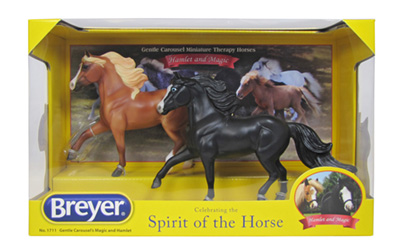
Ocala-based Gentle Carousel Miniature Therapy Horses is an award-winning non-profit organization owned and operated by Jorge and Debbie Garcia-Bengochea.
The husband-wife team uses miniature horses for equine therapy in a unique way, taking their pint-sized horses to hospitals, schools, hospices, and special appearances–wherever they can make a difference.
An enormous amount of training goes into teaching these tiny equine “therapists” to walk up and down stairs, ride in elevators, and calmly handle situations most horses never experience.
Of the Gentle Carousel herd of 20 miniatures, Magic is the most famous, and readily identifiable with her glistening black coat and blue eyes.
The recipient of many awards, Magic was honored as“Most Heroic Pet in America” by AARP , “One of History’s 10 Most Courageous Animals” by TIME Magazine, and “One of Seven Most Notable Animal Heroes in the World” by The Daily Mirror in 2014.
When Breyer contacted Gentle Carousel about making a portrait model of Magic, it was a pleasant surprise.
“We had to keep it a secret before it was announced, which was nearly a year,” says Debbie. “They really wanted Magic, but they decided to do Hamlet, too.” (The two Breyer models were released as a set.)
When attending a charity event and making hospital visits in New York City, Jorge and Debbie even took Magic to the factory in New Jersey where Breyer models are made.
“Jorge, Magic and I toured the factory and met the sculptor who created her original model, so we got to see that before it came out. She was the first horse to tour the factory,” says Debbie.
“We appeared at BreyerFest 2014 and visited Kentucky Children’s hospital and the Ronald McDonald House in Lexington at the same time. BreyerFest is a big deal so to have one of the Breyer horses then go into the hospital there and see the kids was a big deal.”
Magic is now 14 and Hamlet is 9. Along with the rest of the Gentle Carousel Therapy Miniature Horses, Magic continues to spread care and good will to people of all ages in Ocala and far beyond.
Images above courtesty of Breyer®
Be sure to check out the second installment of our series about Breyer horses with Ocala connections :
Breyer Horses – Forever in Our Hearts: Part 2
